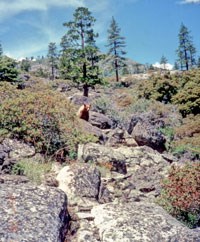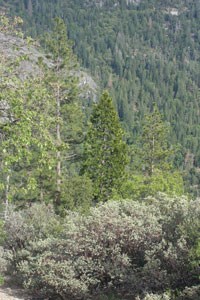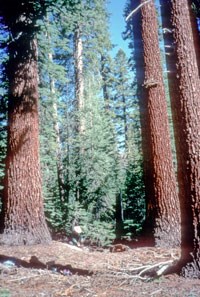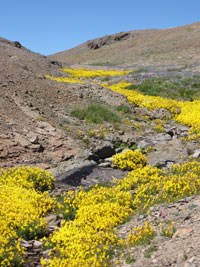|
The native plants of Yosemite National Park are a significant part of the exquisite beauty and biological diversity of the park. Move up or down in elevation and feel as though you are in another park. Vegetation changes from oak woodlands to chaparral scrublands to lower montane to upper montane to subalpine to alpine. Those who step into the alpine zone can see krummholz whitebark pines and perhaps a western juniper or mountain hemlock. Scientists study many individual plants, including the black oak, to understand its future challenges. The combination of climate, topography, moisture, and soils influence the distribution of plant communities across an elevation gradient from 1,800 feet (549 m) to over 13,000 feet (3,900 m). Vegetation zones range from scrub and chaparral communities at lower elevations, to subalpine forests and alpine meadows at the higher elevations. There are 800 miles of trails in Yosemite, which provide access for exploring the different vegetation zones. 
Foothill-Woodland ZoneThe lowest elevations in Yosemite are found on the western boundary of the park at the El Portal Administrative Site, which is at approximately 1,800 feet (549 m). This is the foothill-woodland zone, an area that is hot and dry in the summer with very little or no snow in the winter. Plants within this zone include chamise, ceanothus, manzanita, blue oak, interior live oak, and gray pine. These plant communities can also be found near Hetch Hetchy reservoir. 
Lower Montane ForestBeginning near the 3,000 foot (900 m) elevation, the hot, dry summers and cool, moist winters of the Mediterranean climate give rise to the lower montane forest zone. The accumulation of several feet of snow during the winter is not uncommon and can stay on the ground for several months. The diversity of tree species found in this zone make this a beautiful and interesting forest to explore. The lower montane forests are found along the western boundary of the park and include trees such as California black oak, ponderosa pine, incense-cedar, and white fir. Yosemite’s giant sequoia groves including the Mariposa, Merced, and the Tuolumne Groves are also found within this vegetation zone. The lower montane forest encompasses 166,000 acres (87,200 ha) and can be seen in Yosemite Valley and along the Wawona, Hetch Hetchy, and Big Oak Flat Roads. 
Upper Montane ForestThe upper montane forest begins at higher elevations near 6,000 feet (1800 m), where the montane climate is characterized by short, moist, cool summers and cold, wet winters. Snow begins to fall in November and may accumulate to depths up to six feet and remain until June. Pure stands of red fir and lodgepole pine are typical of this forest. Jeffrey pine, which has bark that smells like vanilla, and the picturesque western juniper can also be found in this zone. Beautiful wildflowers bloom in meadows from June through August. Upper montane forests encompass 216,000 acres (87,000 ha) and may be viewed from the Tioga Road east of Crane Flat and in areas north and south of Yosemite Valley, such as along the Glacier Point Road. 
Subalpine ForestThe upper montane forest is replaced by the subalpine forest near 8,000 feet (2450 m), where the climate is cooler with an even shorter growing season due to long, cold, and snowy winters. Accumulations of three to nine feet of snow are typical. The western white pine, mountain hemlock, and lodgepole pine are found in this forest with many subalpine meadows that flower from July through August. This zone can be seen from the Tuolumne Meadows area east to Tioga Pass and encompasses 297,000 acres (120,000 ha). 
Alpine ZoneThe alpine zone of Yosemite begins near the 9,500 foot (2,900 m) elevation and is easily distinguished as it is above tree line. No trees grow in this zone due to the harsh climatic conditions. Short, cool summers with long, cold, and snowy winters are typical at these elevations. Many exposed granitic outcroppings, talus slopes, and boulder fields limit the amount of vegetation that grows here. The herbaceous plants need to flower and produce their seeds quickly during the short, frost-free period of summer. This zone covers 54,362 acres (22,000 ha) in Yosemite and is only viewed up close by hiking or climbing into the high elevations of Yosemite's wilderness. Park botanists, in 2010-2012, will be conducting a botanical inventory of the park's sky-island floras--which are specialized plant communities that occupy dry, cold plateaus at the crest of the Sierra Nevada from Yosemite south to Sequoia-Kings Canyon. These plants are highly vulnerable to drying and warming predicted by many climate forecast models. With this type of data, park managers can determine resource protection strategies. View more about Yosemite National Park's research and studies. Learn More
|
Last updated: August 22, 2023
